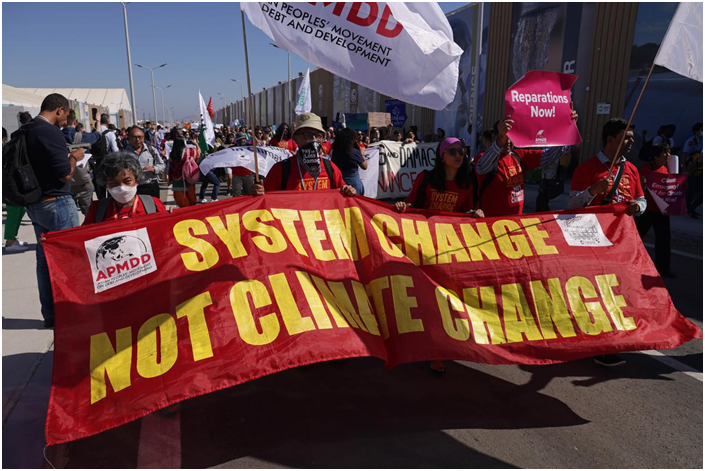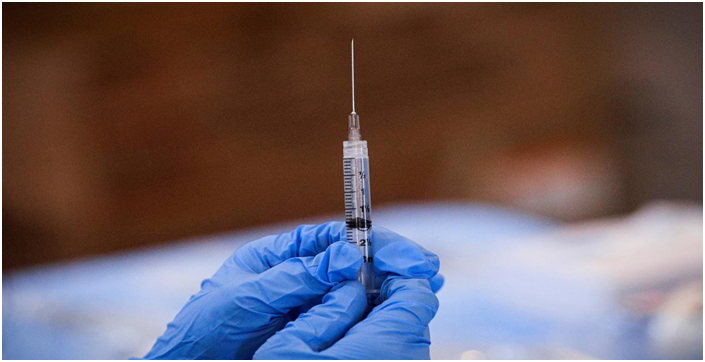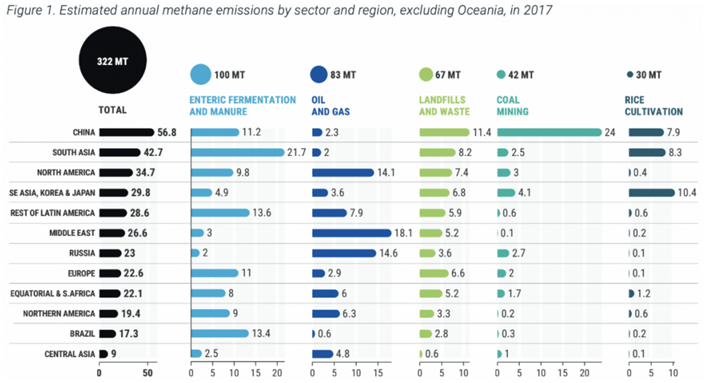Talks on 1.5°C at a cliff edge at COP27 (GS Paper 3 Environment)

Context:
- The scientific community is losing hope that temperature rise can be stopped in time, before uncontrollable tipping points are reached, leading to catastrophic climate change that will harm human health, biodiversity, and agriculture.
- This has provoked global protest movements. Youth in particular are restive at their uncertain future.
Background:
- After the ratification of the Paris Agreement on Climate Change of 2015, the focus is on voluntary national actions to drive down greenhouse gas emissions and keep the rise in average global temperature to well below 2°C and as close to 1.5°C as possible by the end of the century.
- All nations that signed on to the pact under the UN Framework Convention on Climate Change (UNFCCC) are meeting in Sharm el-Sheikh, Egypt, at the COP27, to review progress, raise ambition on emissions cuts and draw up funding plans to help vulnerable countries adapt to climate change.
Why is the 1.5°C goal seeming unattainable?
- Scientific reports from the UN that contribute to the understanding of climate change released ahead of the COP27 meeting in Egypt point to the extremely narrow window available to close the emissions gap and prevent rise in average temperature beyond 1.5°C.
- The UNEP’s Emissions Gap Report 2022 says, even if all the conditional Nationally Determined Contributions (NDCs) followed by targets to reduce emissions to net-zero are implemented, global warming is projected to rise to 1.8°C with a 66% probability.
- The report also points out that global annual emissions during 2021 at 52.8 Gigatonnes (GtCO2e), represents a slight increase compared to 2019, the pre-COVID year, and that the outlook for 2030 is not bright.
- Collectively, G20 members account for 75% of emissions, although it is the richer countries that are responsible for accumulated emissions since the industrial revolution.
Tipping points:
- The key tipping points are the potential Greenland ice sheet collapse, West Antarctic ice sheet collapse, thawing of the boreal permafrost, and tropical coral reef die offs, all of which are expected to happen at 1.5°C.
- Tipping points represent moments that cascade into irreversible changes, with a domino effect on other elements such as monsoons and heat waves.
- To put things in perspective, the current temperature rise stands at 1.2°C to 1.3°C over the pre-industrial average, the highest in about 12,000 years since the last Ice Age. With the present soft approaches to limiting atmospheric CO2, it will be almost impossible to achieve the 1.5°C target.
What do scientific reports say on the fallout?
- The COP27 is described as the conference of implementation, given that UN climate talks are often criticised as a ‘talk more, do little’ exercise.
- Yet, official reports of the Intergovernmental Panel on Climate Change (IPCC) which inform the UN system have reminders for the participating leaders, whose national pledges fall well short of the reductions needed.
- The latest Sixth Assessment Report (SAR) of the IPCC, with high confidence in its conclusions for the near term (until 2040), says that biodiversity loss, Arctic ice loss, threat to coastal settlements and infrastructure will all be experienced, while conflicts, migration of affected people and urban challenges to energy and water access could also arise.
- Beyond 2040 and until the end of the century, the IPCC report paints a grim picture. At 2°C, up to 20% decline in snowmelt water for irrigation, diminished water for farming and human settlements due to glacier mass loss, and a two-fold increase in flood damage could happen, while up to 18% of species on land could go extinct.
- Of particular concern in the tropical regions is the projected increase in the frequency and intensity of extreme weather events such as cyclones, particularly in the medium to long term until 2100.
What is the focus of negotiations at COP27?
- Countries most affected by the effects of a changing climate have been seeking loss and damage payments from the richer industrialised nations, who have contributed the bulk of CO2 in the atmosphere. Firming up this compensation mechanism is a major area of focus at COP27.
- The emerging economies and small climate-affected countries argue that they were not responsible for this stock of CO2, and many want a massive loss and damage fund created, separate from the $100 bn per year agreed to under the Paris Agreement.
- At the COP in Glasgow, this agenda was kicked down the road. Some communities in countries ranging from Peru to Pakistan and even India have started filing climate cases, seeking restraints or damages.More fundamentally, activists are seeking a sharp move away from fossil fuels to peak emissions by 2025.
Way Forward:
- A special report titled “10 New Insights on Climate Science” released at COP27 by Prof. Rockstrom points to continuing high emissions from fossil fuels because “success is still measured predominantly by GDP and affluence, rather than through improvements in resource use efficiency and advancing human well-being within the biosphere’s constraints.”
- World leaders and the financial system investing in polluting companies worldwide are, therefore, under pressure to divest from fossil fuels and support greener renewable options at COP27.
Can vaccine distribution be made fairer?
(GS Paper 3, Science and Tech)
Context:
- Only one in four people has been vaccinated with at least one dose in low and middle income countries as of November 9, 2022.
- In comparison, in high income countries, three in four people have got at least one dose of the vaccine as per the recent report of the Global Dashboard for Vaccine Equity.
What is the Global Dashboard?
- The Global Dashboard for Vaccine Equity is a joint effort by the United Nations Development Programme (UNDP), the World Health Organization (WHO) and the University of Oxford with cooperation across the UN system.
- The Global Dashboard for Vaccine Equity combines the latest data on the global roll-out of COVID-19 vaccines with the “most recent socio-economic information to illustrate why accelerating vaccine equity is not only critical to saving lives but also to driving a faster and fairer recovery from the pandemic with benefits for all.”
- It provides new, actionable insights and possibilities for policy makers to dive into the implications of vaccine inequity for socio-economic recovery, jobs and welfare.

What is vaccine equity?
- Everyone in the world has the same access to vaccines. A study indicated how, early on in the COVID-19 pandemic, vaccine production was insufficient to meet global demand.
- Many wealthy countries turned inwards, procuring vaccine doses through exclusive bilateral deals for their domestic populations (vaccine nationalism), and manufacturing countries, such as India, imposed temporary export bans. These events catalysed the global vaccine inequity that is still evident today.
- The “widening gaps in global vaccine equity have led to a two-track pandemic with booster COVID-19 vaccinations proliferating in high-income countries (HICs) and first doses not yet reaching all populations in low-income countries (LICs).”
- WHO Director-General TedrosAdhanomGhebreyesus using the strongest of terms for this divide, called it: ‘Vaccine Apartheid’.
Impact on healthcare costs:
- While vaccination programmes will increase healthcare costs across all countries, it is especially the case in low-income countries as they would need to increase their health expenditure by a staggering 30-60% to reach 70% of their population under the current pricing.
- High-income countries are expected to increase theirs by only 0.8% to achieve the same vaccination rate in one year.
Were efforts taken to reduce vaccine inequity?
- It was reported that during the height of the pandemic, efforts were initiated to waive the intellectual property protection for the COVID-19 range of therapeutics and vaccines, in order to ensure that affordability alone doesn’t determine availability.
- A waiver in the TRIPS agreement was proposed as a radical way to overcome the anticipated shortfalls. However, that did not come through.
COVAX:
- What did come through was ‘The COVID-19 Vaccine Delivery Partnership (COVAX), a collective international effort with ‘One Country Team’, ‘One Plan’, and ‘One Budget’ which was launched by WHO, UNICEF, and Gavi and the World Bank, to intensify country readiness and delivery support.
- It aimed at accelerating COVID-19 vaccination coverage in 34 low coverage countries, along with their governments.
- While COVAX has helped many countries access vaccines, since its launch in January 2022, low income countries (LICs) particularly continue to have difficulties in achieving a step change in vaccination rates, the WHO records.
- Further, unless it can support LICs beyond the 20% vaccination rate, the financial burden of vaccinating an additional 50% of the population will fall on most vulnerable countries.
What lies ahead?
- Going by WHO’s dictum that no one is safe until everyone is safe, it is imperative that adequate quantities of COVID-19 vaccine are available to countries across the world, particularly at a time when the risk of new variants causing further waves of infections is still alive.
- The WHO has called for “concerted and urgent action from countries, international partners and agencies, along with G20 Finance Ministers is required to increase vaccination levels and expedite access.”
A satellite data system will help detect, act on methane emissions
(GS Paper 3, Environment)
Why in news?
- Recently, the Methane Alert and Response System (MARS)was launched at the 27th Conference of Parties (COP27) to the United Nations Framework Convention on Climate Change in Sharm El-Sheikh, Egypt.
- It will now help governments detect methane emissions and tackle them.
Significance:
- MARS is a part of global efforts to slow climate change by tackling the global warming gas.
- The data-to-action platform was set up as part of the UN Environment Programme’s (UNEP) International Methane Emissions Observatory (IMEO) strategy to get policy-relevant data into the right hands for emissions mitigation.
Methane as GHG:
- Methane is an 80 times more potent greenhouse gas than carbon dioxide. It accounts for a small portion of human-induced greenhouse gas emissions compared to carbon dioxide.
- But it is thought to be 80 times more efficient than carbon dioxide at trapping atmospheric heat in the 20 years following its release.
Stakeholders:
- The system will be the first publicly available global system to connect methane detection to notification processes transparently.
- It will use state-of-the-art satellite data to identify significant emission events, notify relevant stakeholders, and support and track mitigation progress.
Global Methane Pledge:
- The countries must cut methane emissions by at least 30 per cent by 2030, the goal of the Global Methane Pledgeto keep the 1.5°C temperature limit within reach, according to the Intergovernmental Panel on Climate Change (IPCC).
- Cutting methane is the fastest opportunity to reduce warming and keep 1.5°C within reach, and this new alert and response system is going to be a critical tool for helping all of us deliver on the Global Methane Pledge.
- Global Methane Pledge participants agree to take voluntary actions to contribute to a collective effort to reduce global methane emissions by at least 30 per cent from 2020 levels by 2030, which could eliminate over 0.2˚C warming by 2050. This is a global, not a national reduction target.

Global mean temperature:
- The past eight years are on track to be the eight warmest on record, fuelled by ever-rising greenhouse gas concentrations and accumulated heat, a recent report by World Meteorological Organization said.
- The global mean temperature in 2022 is currently estimated to be about 1.15 degrees Celsius (°C) above the 1850-1900 pre-industrial average,” with a range of 1.02°C to 1.28°C.
- United States’ National Aeronautics and Space Administration’s (NASA) scientists recently found 50 “super-emitters” of methane gas in central Asia, the west Asia and the southwestern United States. Most of these sites have ties with agriculture and fossil fuel industries.
Way Forward:
- If requested, MARS partners will also provide technical or advisory services, such as help in assessing mitigation opportunities.
- UNEP will continue to monitor the event location and make the data and analysis available to the public between 45 and 75 days after detection.




